Manuscript accepted on :
Published online on: --
Standardisation of Recipe for Fish Ball in Curry from Catlacatla
A. D. Kolekar, A. U. Pagarkar, J. C. Kedar, T. E. ,Baug and V. R. Bhatkar
Department of Fish Processing Technology and Microbiology, College of Fisheries, Shirgaon, Ratnagiri- 415629, Maharashtra, India.
Corresponding Author E-mail: pagarkarau@gmail.com
ABSTRACT: A method of preparation of fish ball in curry, having a standard size of 10 g weight of fish ball from catla has been developed, by using surimi of catla. Different ingredients viz., ginger, garlic, green chilly and starch were standardised for preparation of fish ball in curry. The sensory evaluation showed that the quantity of 0.51 g ginger paste was found superior than 0.21, 0.31, 0.41 and 0.61g in the curry paste. 3.34 g of garlic paste was found best based upon sensory evaluation as compared to 2.34, 2.84, 3.84 and 4.34 g in the fish ball in curry recipe. 1.00 g of green chilly was found to be superior as compared to 0.70, 0.80, 0.90 and 1.10g. Ordinary starch was found to be appropriate as compared to wheat, tapioca, potato and modified starches. The ratio of 60:40 ordinary to modified starch in fish ball was found better than 90:10, 80:20, 70:30 and 50:50 ratios in fish ball.
KEYWORDS: Fish ball; fish product; value addition; ready-to-eat product
| Copy the following to cite this article: Kolekar A. D, Pagarkar A. U, Kedar J. C, Baug T. E , Bhatkar V. R. Bhatkar. Standardisation of Recipe for Fish Ball in Curry from Catlacatla. Biosci Biotech Res Asia 2012;9(2). |
| Copy the following to cite this URL: Kolekar A. D, Pagarkar A. U, Kedar J. C, Baug T. E , Bhatkar V. R. Bhatkar. Standardisation of Recipe for Fish Ball in Curry from Catlacatla. Biosci Biotech Res Asia 2012;9(2). Available from: https://www.biotech-asia.org/?p=10164 |
Introduction
The present trend of consumer particularly urban consumers are showing more and more interest in food products which are available in ready-to-eat or ready-to-cook form such as fish fillet, finger, cutlet, patties, burger, sausages and fish balls. These food items are called convenient products. The global demand for such products is increasing rapidly. Present trends marketing reflect a rapidly growing demand for such processed foods that are more convenient to handle, store and prepare. Few factors responsible for such a situation is increasing number of working women, reasonably increase in income, education, awareness and consciousness towards quality, freshness, nutrition, hygiene and health etc. This has led to the development of several fishery products varied in taste, texture and appearance(Pagarkaret al., 2011).
Fish ball in curry is one such product that can be processed as a heat processed product in a suitable fluid medium. Fish ball is palatable and nutritious product prepared from fish surimi. Surimi is an intermediate product, which has characteristic gelling and elastic properties. Surimi can be used to develop products with good, appearance, flavor and texture. Texturisation of surimi involves modification of elasticity with ingredients such as starch, polyphosphates, etc. (SrinivasaGopal, 2011). The preparation of fish ball is simple and can be made with locally availableingredients.
In the present study ready-to-eat convenient product “fish ball in curry” developed from fresh water fish (C. catla) using standardised the recipe.
Materials and Methods
Catla (C. catla) were procured from local fish market and brought to processing hall under iced condition. The fish was washed with potable water, dressed and filleted. Mincing was done by mincer followed by draining and mixing with cryoprotectants, surimithen stored in deep freezer at a temperature of -18ºC until further use. As and when required, surimi was taken out and thawed before use. Chopped onions and tomatoes fried in sunflower oil till it become brown and then they were grinded.
Standardization in the basic recipe (Joshiet al., 2011) (Table 1) were carried out by varying the quantity of different ingredients. Curry paste was prepared by heating oil in frying pan then adding garlic, ginger, coriander seed powder, garam masala and salt. These mixtures were fried then add fried onion paste, red chilly powder and turmeric powder kept for cooking. Fried tomato paste was added and cooked. Curry was prepared by frying curry paste in oil (3% of curry paste). Then boiling was done by adding water (Curry paste: water :: 1:1). The oil was heated in frying pan then turmeric powder was added followed by fried tomato paste then cooked. In one tray dough was made by adding surimi, salt starch fried onion paste, red chilly powder, coriander seed powder, garam masala, ginger paste, garlic paste, green chilly paste, coriander paste and that fried mixture. Fish ball were made each of approximately 10 g weight.
Fish ball in curry was prepared keeping the constant level of onion, tomato, red chilly powder, turmeric powder, coriander powder, garam masala, coriander paste, salt, starch and surimi while varying types and ratios of starch and varying quantities of ginger, garlic, green chilly. Fish ball in curry was subjected to sensory evaluation by a group of ten trained panelist using 9 point hedonic scale (Pagarkaret al., 2007), on the attributes such as colour, taste, texture, odour and overall acceptability.
Ginger paste was standardised in basic recipe and curry paste was prepared with incorporation of different quantities of ginger paste such as 0.21, 0.31, 0.41, 0.51 and 0.61g. All other ingredients were kept constant. Sensory evaluations were carried out to find best quantity.
Garlic paste was standardised in basic recipe and curry paste was prepared with incorporation of different quantities of garlic paste such as 2.34, 2.84, 3.34 and 4.34g. All other ingredients were kept constant.
Green chilly paste paste was standardised in basic recipe and curry paste was prepared with incorporation of different quantities of green chilly paste such as 0.70, 0.80, 0.90, 1.00 and 1.10g. All other ingredients were kept constant. Sensory evaluations were carried out to find best quantity.
Type of starch was standardised in basic recipe and fish balls were prepared with incorporation of different types of starch such as wheat, tapioca, potato and modified starch and ordinary starch. All other ingredients were kept constant. Sensory evaluations were carried out to find best type.
Ratio of starch was standardised in basic recipe and fish balls were prepared with incorporation of different ratios of ordinary starch and modified starchsuch as 90:10, 80:20, 70:30, 60:40 and 50:50.All other ingredients were kept constant. Sensory evaluations were carried out to find best ratio.
The final catla fish ball in curry was prepared using standardised recipe (Table 1) keeping the standardised quantity of ginger0.51g (T4), garlic 3.34g (T3), green chilly 1.00 g (T4),ordinary starch,60:40 (T4) ratio of ordinary to modified starch.
The proximate composition viz. moisture, crude protein, crude fat, ash and carbohydrate content of fish ball in curry were determined following standard methods (AOAC, 2005).
Results and Discussion
Standardisation of different ingredients viz.,ginger 0.51 g (T4), garlic 3.34g (T3), green chilly 1.00 g (T4), ordinary starch (T5) and 60:40 (T4) ratio of ordinary to modified starchshowed better sensory values compared to other ratios (Fig.1, Fig.2, Fig.3, Fig.4 and Fig.5) The Sensory evaluation of the fish ball in curry indicated the highest score for this standardised recipe (Table 1).
Table 1: Basic and standardized recipe of catla fish ball in curry.
|
Sr. No. |
Ingredients | Quantity(g) | ||
| Basic
(Joshi et al., 2011) |
Standardized |
|||
| 1. | Fish surimi | 100 | 100 | |
| 2. | Salt | 2 | 2 | |
| 3. | OS:MS* (60:40) | 15 | 15 | |
| 4. | Curry paste | 40 | 40.20 | |
| Curry paste | ||||
| 1. | Onion paste | 24.60 | 24.60 | |
| 2. | Tomato paste | 4.92 | 4.92 | |
| 3. | Garlic paste | 3.34 | 3.34 | |
| 4. | Chilly powder | 0.82 | 0.82 | |
| 5. | Turmeric powder | 0.37 | 0.37 | |
| 6. | Coriander seed powder | 0.62 | 0.62 | |
| 7. | Garam masala | 0.87 | 0.87 | |
| 8. | Green chilly paste | 0.90 | 1.00 | |
| 9. | Coriander paste | 0.90 | 0.90 | |
| 10. | Ginger paste | 0.41 | 0.51 | |
| 11. | Salt | 2.25 | 2.25 | |
Table 2: Proximate composition of catla fish ball in curry.
| Attribute | Value |
| Moisture (%) | 68.12 |
| Crude Protein (%) | 15.73 |
| Fat (%) | 8.75 |
| Ash (%) | 3.18 |
| Carbohydrate (%) | 4.22 |
Catla fish ball in curry prepared with 0.51 g ginger paste in curry paste showed better sensory score than other quantities of ginger paste in curry paste used for preparation of catla fish ball in curry (Fig. 1).Species differentiationmay cause difference in the quantity of ginger paste.
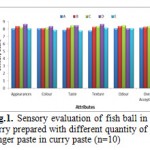 |
Figure 1: Sensory evaluation of fish ball in curry prepared with different quantity of ginger paste in curry paste (n=10).
|
Similar results with slight variation were found by Joshi et al. (2011), they used 0.41 g of ginger paste in curry paste for preparation of fish ball in curry. Kamat (1999) used 1.06 g of ginger paste for curry paste in fish ball in curry prepared from surimi of mackerel (Rastrelligerkanagurta).
Catla fish ball in curry prepared with 3.34 g garlic paste in curry paste showed better sensory score than other quantities of garlic paste in curry paste used for preparation of catla fish ball in curry(Fig. 2).Sensory evaluations were carried out to find best quantity.Species differentiation may cause difference in the quantity of garlic paste.
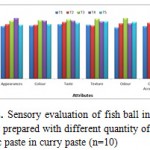 |
Figure 2: Sensory evaluation of fish ball in curry prepared with different quantity of garlic paste in curry paste (n=10) |
Similar result was found by Joshi et al. (2011), they used 3.34 g of garlic paste in curry paste for preparation of fish ball in curry. Kamat (1999) used 2.72 g of garlic paste for curry paste in fish ball in curry prepared from surimi of mackerel (R. kanagurta). Mote (2001) used 5 gof garlic paste in curry paste for fish ball in spinach curry.
Catlafish ball in curry prepared with 1.00 g green chilly paste in curry pasteshowed better sensory score than other quantities of green chillypaste in curry paste used for preparation of catla fish ball in curry(Fig. 3).Species differentiationmay cause difference in the quantity of green chilly.
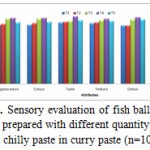 |
Figure 3: Sensory evaluation of fish ball in curry prepared with different quantity of green chilly paste in curry paste (n=10)
|
Similar results with slight variation were found by Joshiet al. (2011), they used 0.90 g of garlic paste in curry paste for preparation of fish ball in curry. Balangeet al. (2002) used 0.73 g of green chilly paste for curry paste in fish ball in curry prepared from surimi of pink perch (N. japonicus).
Catla fish ball in curry prepared with ordinary starchin fish ball showed better sensory score than other types of starch used for preparation of catla fish ball(Fig. 4).Species differentiationmay cause difference in the type of starch selected.
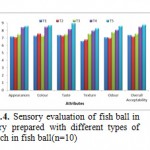 |
Figure 4: Sensory evaluation of fish ball in curry prepared with different types of starch in fish ball(n=10)
|
Similar results with slight variation were reported by Mote (2001), he used corn flour as a starch in preparation of fish ball from pink perch (N. japonicus) surimi. Noitup and Raksakulthai (1997) used different types of starches such as corn starch, tapioca flour and wheat flour for preparation of fish and cuttlefish balls. He found that different kinds of starch did not significantly affect the quality of the fish-cuttlefish ball.
Catla fish ball in curry prepared with 60:40 (w/w) (T4) ratio of modified to ordinary starch fish ball showed better sensory score than other ratios of modified to ordinary starch used for preparation of fish ball(Fig. 5).Modified starch most effectively reduced expressible moisture, maintaining good water binding. Freeze-thaw stable modified starch does not undergo retrogradation and thus can bind water during freeze-thaw cycles without syneresis (Lee et al., 1988).
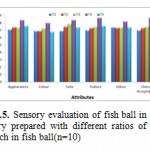 |
Figure 5: Sensory evaluation of fish ball in curry prepared with different ratios of starch in fish ball(n=10).
|
Similar results with slight variation were recorded by Desai et al. (2007), he used 60:40 combination of ordinary starch and modified starch for preparation of fish ball in curry prepared from surimi of pink perch (N. japonicus).
Processing of catla into value-added ready-to-eat product enhance their acceptability. Fish ball in curry prepared using standardised recipe was excellent in taste, texture, colour, odour and have good overall acceptance.
Acknowledgement
The authors are thankful to University authorizes of Dr. B. S. KokanKrishiVidyapeeth, Dapoli, College of Fisheries, Ratnagiriand staff members of NAIP for encouragement and providing necessary facilities and help for the present work.
References
- AOAC, (2005) Official methods of analysis of the Association of Official Analytical Chemists International, 18th edition, In: Horwitz, W. (Ed.), AOAC, Washington (D. C.), 35: 2-36.
- Balange A. K., Joshi V. R., Pagarkar A. U. and Dagare R. A. (2002) Standardization of fish ball in curry at pasteurization temperature. Applied Fisheries and Aquaculture,II (1): 25-28.
- Desai A. S., Joshi V. R. and Pagarkar A. U. (2007) Effect of modified starch on the shelf life of frozen fish ball in curry at -200C. Asian Jr. of Microbial.Biotech.Env. Sc., 9 (1): 107-112.
- Joshi V. R., Pagarkar A. U. and Baug T. E. (2011) “Fish ball in curry” leaflet. Published by Pilot scale demonstration of fish ball in curry, College of fisheries, Ratanagiri, Funded by Rajiv Gandhi Science and Technology Commission, 6 pp.
- Kamat A. K. (1999) Preparation of fish ball and fish cutlet from mackerel mince meat. M.F.Sc. thesis submitted, Dr. BalasahebSawantKokanKrishiVidyapeethDapoli, Maharashtra, 200 pp.
- Lee C. M., Chung K.H. and Kim J.M. (1988) Mechanisam of freeze-thaw stabilizing effect of modified starch in surimi based products. Paper No. 36, presented at the 49th annual meeting of Institute of Food Technologists, New Orleans, LA, June 19-22.
- Mote M. V. (2001) Cook-chill storage of fish ball in spinach curry. M.F.Sc. thesis submitted, Dr. BalasahebSawantKokanKrishiVidyapeethDapoli, Maharashtra, 114 pp.
- Noitup P. and Raksakulthai N. (1997) Process development and storage of fish-cuttlefish balls.ASEAN Food J., 12 (1): 27-32.
- Pagarkar, A. U., Basu, S. and Mitra, A. (2007) Extruder- A novel technology for development of value added fish products. Beverage and Food World Journal. 34 (1): 72-75.
- Pagarkar A. U., Joshi V. R., Baug T. E. and Kedar J. G. (2011) Value addition is need of seafood industries. FISHCOOPS, 23(4): 8-17.
- SrinivasaGopal T. K. (2011) Fish processing technology, In: Handbook of fisheries and aquaculture, Ayyapan S. (Ed.), Indian council of agriculture research, New Delhi, 31 pp.

This work is licensed under a Creative Commons Attribution 4.0 International License.





